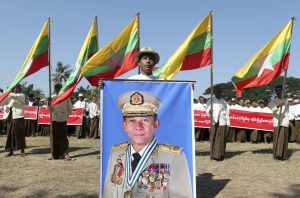By Amara Thiha

An activist holds a portrait of Sen. Gen. Min Aung Hlaing during a rally to support Myanmar’s military in Naypyitaw, Myanmar, Wednesday, Jan. 23, 2019.Credit: AP Photo/Aung Shine Oo
Myanmar has transitioned into a quasi-democratic administration by completing the seven-step road map laid down by the military regime in 2003. The vision prepared by the Myanmar military (known as the Tatmadaw) with the 2008 constitution is now in full swing. However, there remains one hard nut to crack: The Tatmadaw’s role, a vision for the future, and the recalibration of Myanmar’s political landscape.
After putting together the pieces based on the Tatmadaw’s official releases, here are five things we know about the military’s position in the new Myanmar.
One Country, Two Institutions
The civil-military relationship during the U Thein Sein administration (2010-2015) was not always smooth sailing, but it was still functional due to both institutional arrangements (defense and security meetings) and institutional memories, supplemented with relationships that had developed between the stakeholders during their service years in the military. These functioning mechanisms ceased during the National League for Democracy (NLD) administration. Instead, the Tatmadaw became a separate institution with almost no oversight and minimal coordination between civil and military agencies for the first time.
Possessing strong institutional capacity along with political ambitions, the Tatmadaw functions as a parallel institution to the state, as is visible in nearly every area: from COVID-19 responses to the peace process and international engagements. On December 22, Commander-in-Chief Senior General Min Aung Hlaing stated that “Tatmadaw and and the nation (state) are the necessary institutions and Tatmadaw is necessary for defense duties to maintain the government of the state.” Indeed this is the starting point to understand the Tatmadaw’s position; it is loud and clear. The military is positioning itself neither above nor below the state; it is a parallel institution responsible for defense duties.
Expanded Defense Duties
The scope of these defense duties has also expanded from external and internal threats to include other areas. Protecting national interests, defending sovereignty, and the new area of humanitarian assistance and disaster relief are now included in the defense domain. In addition, the scope of the national interest has also been re-defined to grant the Tatmadaw a leading role in defending Myanmar’s “national politics,” religion and Sasana (meaning Buddhism), traditions, and customs and culture. The national interest was previously defined just with “race, religion and tradition.” This is the first time the Tatmadaw expanded and clearly defined the scope of its defense duties.
The Guardian of the Nation for National Politics
While performing the primary objective of defense duties, the Tatmadaw also gave themselves the duty of performing as a guardian of the nation by leading “national politics.” That addition allows the Tatmadaw to position the military above all other institutions, ideologies, and political parties. By keeping a morally superior position, the Tatmadaw develops a holistic ground for Myanmar politics based on its old touchstone, the “Three Main Causes” (“Non-disintegration of the Union, non-disintegration of national solidarity, and perpetuation of sovereignty.”)
Three Main Causes as the Ideological Cornerstone
Starting with the political objectives in the 1990s, the Three Main Causes become the fundamental principles of the constitution and now the ideological cornerstone for national politics, as defined by the Tatmadaw. The military considers the Three Main Causes as the purest form of the idea for the state of Myanmar, regardless of the political system and type of government. It is the “idea that shall maintain until the world ends.” With reaffirmation from the commander-in-chief that the “Tatmadaw will fiercely protect the Three Main Causes,” the Tatmadaw lay down the cornerstone for seeking ideological purity in the political sphere as part of its mission.
The Peace Process as the Major Political Arena
By reinforcing the peace team with experienced and decorated generals soon after the election, the Tatmadaw signaled that the peace process is the arena for keeping its political role and structural adjustment of the state. By engaging with the Arakan Army (AA), the hostility in Rakhine State has been significantly reduced, raising the possibility of a by-election in 2021. By creating the political space for ethnic political parties and ethnic armed organizations (EAOs) to address structural issues through the peace process, the Tatmadaw is overriding legitimacy issues and putting its state-building ideas on the table. But the military is keeping its own sequencing, with a focus on cessation of hostilities (i.e. a ceasefire) as the first step toward peace. The Tatmadaw views the end of conflict as a fundamental necessity for federal democracy and still focuses on disarmament as a primary goal.
At the same time, EAOs believe that federal democracy is the key to peace – not the other way around. However, the previous elections proved that ethnic political parties face long odds to win in the current electoral system. Under these circumstances, disarmament will be a heavy lift. Without addressing the conflicting priorities between the Tatmadaw and EAOs, peace is just a castle in the air, and the peace process is little more than a venue for heated dialogue.
Ten years after Myanmar’s political transition began, there is no sign of the country attempting to challenge the position granted to the Tatmadaw by the 2008 constitution. Instead, the military’s political hegemony remains and even thrives. The Tatmadaw, the institution that shaped the state, is now preparing to keep its Zeus-like status in the next phase of Myanmar’s political evolution.
Amara Thiha is the senior research manager at Myanmar Institute for Peace and Security (MIPS) and a nonresident fellow at the Stimson Center. The views and opinions expressed here do not necessarily reflect the policies or positions of MIPS and Stimson Center.
No comments:
Post a Comment